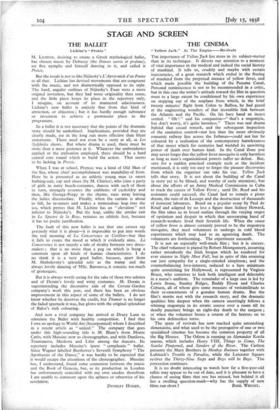THE CINEMA
" Yellow Jack." At The Empire— Revivals
THE importance of Yellow Jack lies more in its subject-matter than in its technique. It directs our attention to a moment of vital importance in the medical and indeed the social history of mankind. It tells us, crudely and maybe with certain inaccuracies, of a great research which ended in the freeing of mankind from the perpetual menace of yellow fever, and which made possible the building of the Panama Canal. Personal reminiscence is not to be recommended in a critic, but in this case the writer's attitude toward the film in question must to a large extent be conditioned by his own experience on stepping out of the seaplane from which, in the brief twenty minutes' flight from Colon to Balboa, he had gazed at the engineering wonders of that incredible link between the Atlantic end the Pacific. On his bare hand an insect settled. " Oh ! " said his companion—" that's a stegomyia, but don't worry, it's quite harmless." There was real drama behind that casual remark, and the subsequent inspection of the sanitation control—not less than the more obviously romantic railway line across the Isthmus—could not but be coloured by a realisation of the contemporary harmlessness of that insect which for centuries had wielded its unwitting power of death over human kind. In the Canal Zone you may never forget that the yellow fever mosquito is only harmless as long as man's organisational powers suffer no defeat. But, save for a sudden practical example such as the incident mentioned, it is only too easy to forget the pioneer discoveries from which the organiser can take his cue. Yellow Jack tells that story. It is not about the building of the Canal (a story yet to be filmed, and worthy of early attention), but about the efforts of an Army Medical Commission in Cuba to track the causes of Yellow Fever ; until Dr. Reed and his assistants could succeed, the Canal had to remain a pious dream, the ruin of de Lesseps and the destruction of thousands of innocent labourers. Based on a popular essay by Paul de Kruif and adapted by no less a figure than Sidney Howard, the film takes us in broad outline through the varying stages of optimism and despair in which that unwearying band of research-workers lived their feverish life. When the cause of yellow fever is almost certainly proved to be the stegomyia mosquito, they need volunteers to undergo in cold blood experiments which may lead to an agonising death. The volunteers are forthcoming. The experiment succeeds.
It is not an especially well-made film ; but it is sincere. The chief volunteer is played by Robert Montgomery, assuming rather mistakenly the Irish brogue which he rendered for ever sinister in Night Must Fall, but in spite of this retaining our just sympathy for a single-minded simpleton; and the counterbalancing love-interest, reduced to a bare minimum quite astonishing for Hollywood, is represented by Virginia Bruce, who contrives to look both intelligent and delectable in a nurse's uniform. The remainder of a large cast is led by Lewis Stone, Stanley Ridges, Buddy Ebsea and Charles Coburn, all of whom give some measure of verisimilitude to their re-enactments of a genuine human drama. But the film's merits rest with the research story, and the dramatic qualities bite deepest when the camera unerringly follows a whining stegomyia in its erratic course over a room till its deadly puncture brings an eight-day death to the surgeon ; or when the volunteer looses a swarm of the horrors on to his own defenceless torso.
The spate of revivals has now reached quite astonishing dimensions, and what used to be the prerogative of one or two specialised cinemas has become the common property of all the Big Houses. The Odeon is running an Alexander Korda season, which includes Henry VIII, Things to ,Come, The Scarlet Pimpernel, and Sanders of the River. The Carlton presents the Marx Brothers in Monkey Business together with Lubitsch's Trouble in Paradise, while the Leicester Square revives the Thirty-Nine Steps and Boys will be Boys. The procession continues.
It is no doubt interesting to watch how far a five-year-old talkie may appear to be out of date, and it is pleasant to have a chance of seeing films that one has missed, but behind it all lies a swelling question-mark—why has the supply of new










































 Previous page
Previous page